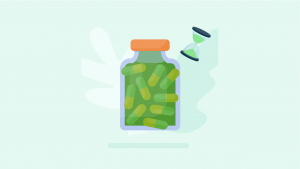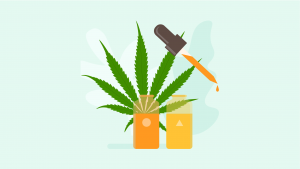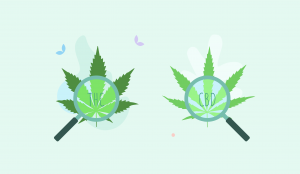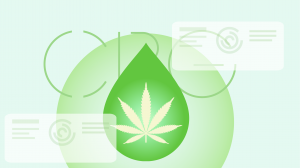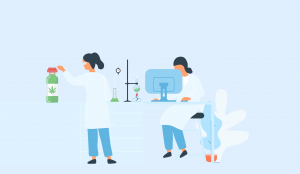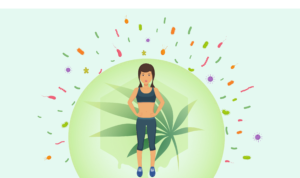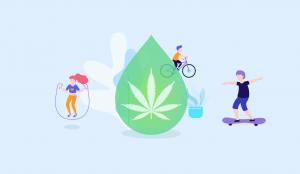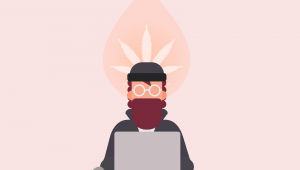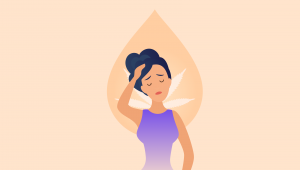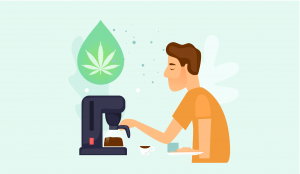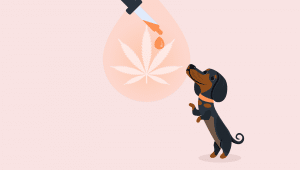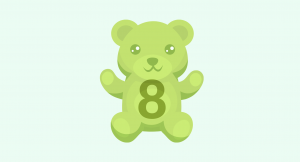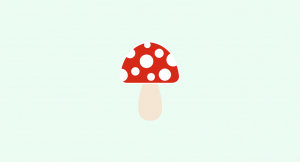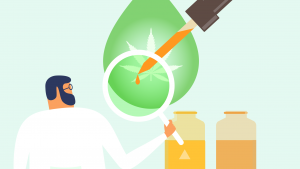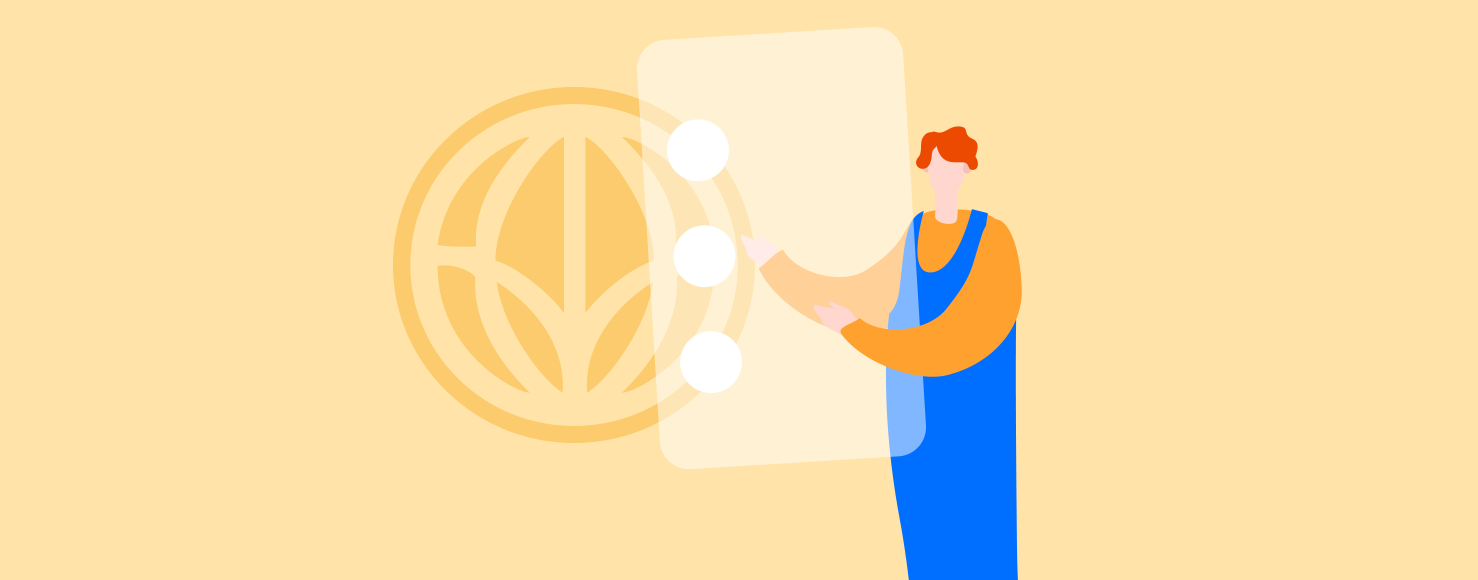
Every Question You’ve Ever Had About CBD — Daily CBD FAQ
Have a question about CBD?
You’re not alone — we receive dozens of questions via email everyday.
Here are the most common questions we get asked about CBD itself, how it works, and how to buy it.
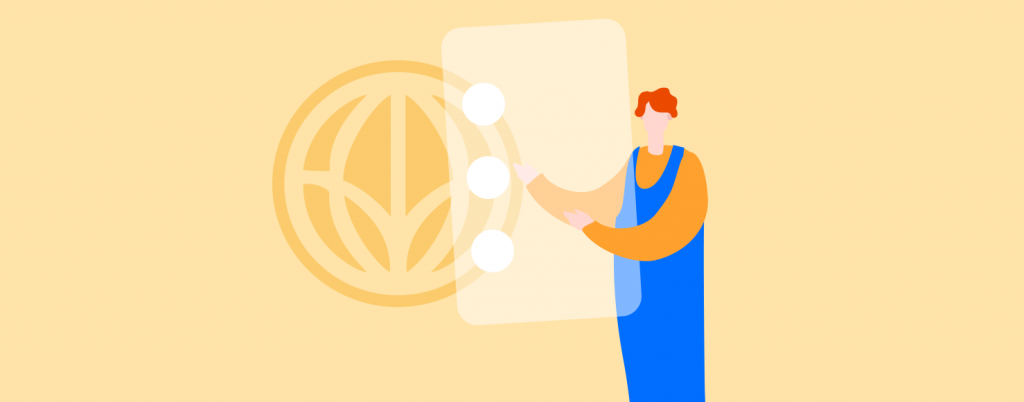
What Is CBD?
CBD is short for cannabidiol. It’s a non-psychoactive extract from the cannabis plant (it won’t make you high).
CBD is suggested to support a wide variety of health conditions and symptoms. This supplement is used to manage neurological disorders like epilepsy, anxiety, and depression. It’s also used to alleviate pain, inflammation, insomnia, and much more.
There are many different ways to use CBD products. You can find CBD in the form of oils, capsules, topical salves, vape pens, edibles, and more.
How Do I Use CBD?
There are five ways to use CBD:
- Internally — in the form of CBD oils, capsules, gummies, or edibles
- Inhalation — in the form of raw hemp flower or vape pens & oils
- Topically — in the form of CBD creams, lotions, and patches
- Injection — intraperitoneal or intravenous injection (medical use only)
- Intravaginally or Intrarectally — in the form of CBD suppositories
The most common way to use CBD is orally in the form of a CBD oil or CBD gummy. CBD creams CBD vape pens are also popular.
What Does CBD Feel Like?
The effects of CBD are subtle. It’s non-psychoactive, which means CBD won’t make you high — however, it can give you a mild “fuzzy” sensation.
The relaxing effects of CBD can make you feel as though you’re floating or hovering. Your body may feel lighter or heavier, and your mind feels loose and relaxed.
The higher the dose of CBD, the stronger these effects are — but even very high doses (over 100 mg) won’t produce strong enough effects to make you high.
Some people describe the effects of CBD as producing an autopilot sensation. It feels like your body is reacting automatically without much conscious thought. While this is happening, you remain perfectly in control, and your mental state remains clear.
Some people may find high doses of CBD makes them feel sleepy or tired. This is especially prevalent in CBD products containing a high concentration of a related cannabinoid called cannabinol (CBN), which is a strong sedative.
What Are the Benefits of CBD?
CBD has many well-documented health benefits. Most of its effects come from its ability to interact with the endocannabinoid system (ECS) — which is made up of a series of receptors spread throughout the body.
Other benefits stem from CBD’s impact on cell regeneration and neurotransmitters such as serotonin and dopamine.
The primary benefits of CBD include:
- Alleviates pain & inflammation
- Supports mental health & wellbeing
- Supports healthy skin
- Protects the brain
- Supports digestive function
- May protect the cardiovascular system
- Supports reproductive health
- Regulates hormones & metabolism
What Are the Most Common Reasons For Using CBD?
Despite the many benefits of CBD, there are seven applications that make up about 80% of the use-cases of CBD:
- Pain relief — arthritis, fibromyalgia, migraine headaches, multiple sclerosis, nerve pain, PMS pain, sickle cell anemia
- Inflammatory conditions — DOMS muscle pain, inflammatory bowel disease, rheumatoid arthritis
- Stress & anxiety relief — anxiety, chronic fatigue syndrome
- Sleep support — insomnia, anxiety
- Depression & mood disorders — bipolar disorder, OCD
- Joint pain & anxiety in pets — arthritis, post-surgery recovery, hip pain, separation anxiety
- Skin inflammation — psoriasis, eczema
How Does CBD Work For Pain?
CBD blocks pain by inhibiting the inflammatory process, regulating pain receptors, and promoting faster recovery of damaged tissue.
The effects of CBD on pain are fast-acting, usually taking effect within 45 minutes of using it (faster for vaped or smoked CBD products), and last for around 4 to 6 hours.
The more you use CBD, the stronger its impact on pain.
The immediate effects come from its ability to activate receptors that modulate pain in the spine. The more you use CBD, the greater its impact (due to its restorative benefits).
How Does CBD Work For Anxiety?
CBD alleviates anxiety by targeting several independent mechanisms involved with hyperactivity in the nerves.
CBD has been shown to boost GABA activity in the brain — which is responsible for calming down the brain. It acts like the brake pedal for the mind, slowing it down when it becomes anxious.
CBD also works to regulate serotonin and dopamine production, relax tense muscles in the neck and shoulders, promote more restorative sleep, and reduce cortisol levels in the blood.
The benefits of CBD for anxiety require about 30 to 45 minutes to take effect and lasts around 4 or 5 hours.
The best CBD oils for anxiety are made from a full-spectrum hemp extract, use organic hemp, and provide a relatively high concentration of CBD per bottle (at least 500 mg per ounce).
How Can CBD Help Me Sleep?
CBD can help you sleep by alleviating the common causes of insomnia — such as anxiety, chronic stress, or pain.
It’s important to combine sleep with adequate sleep hygiene. This involves other lifestyle changes that can be used to support a healthy sleep cycle.
Some examples of proper sleep hygiene include:
- Avoiding computer or phone screens at least an hour before bed
- Avoiding stimulants in the late afternoon and evening
- Going to bed and waking up at the same time each day
- Dimming the lights in the evening
- Using blue-light filters on your computer screens in the evening
- Practicing yoga, meditation, or wind-down techniques before bed
The best CBD oils for sleep are made from a full-spectrum extract rich in sleep-supportive terpenes and cannabinoids. Ideally, a CBD oil for sleep should contain at least 50 mg of CBD per milliliter of oil.
Does CBD Support Weight Loss?
The benefits of CBD for weight loss rely on its ability to reduce appetite, ease the inflammatory load, support hormone balance, regulate mitochondrial function, and alleviate underlying blood sugar dysregulation.
CBD is not considered effective for weight loss on its own but offers an impressive range of benefits when combined with other diet and lifestyle changes.
Overall, the best way to lose weight is through diet and exercise.
Is CBD Good For Skin?
CBD is great for irritated, inflamed, dry, or acne-prone skin. It reduces the thickness of the sebum on the skin — which helps prevent clogged pores and acne. CBD also offers anti-inflammatory benefits that can help with irritated skin conditions like eczema, psoriasis, or allergic dermatitis.
CBD skincare products are becoming increasingly popular as more people learn about the benefits of CBD for the skin and how to use CBD products to maintain skin health.
How Does CBD Work For So Many Health Conditions?
The list of benefits associated with CBD is very long. Our database contains over 55 individual health benefits alone. We’re much more skeptical than other sources who often cite more than 100 separate benefits — many of which are loosely based on fact.
So how is it that CBD has so many benefits?
The answer lies in the specific receptors CBD interacts with.
Most health supplements of medications target a specific receptor that triggers a specific effect. SSRI medications, for example, block the reuptake of serotonin — causing serotonin levels to rise. It has one trigger, with one effect.
CBD is very different. It targets a series of receptors that make up the endocannabinoid system (ECS). The ECS is involved with hundreds of different functions in the human body. By targeting this broad-acting system CBD is able to interact with virtually every organ in the human body.
Through its effects on the ECS, hemp extracts are able to interfere with pain transmission, inflammation, anxiety, sleep, and more.
In summary, CBD has so many benefits because it targets a regulatory system, rather than focusing its effects on one specific pathway with one specific effect.
What’s The Difference Between Hemp & Marijuana?
Hemp and marijuana are the same species of plant — Cannabis sativa.
Like other plants, cannabis has many different forms (called phenotypes) depending on its genetic lineage and growing environments. Even though two plants may be the same species, they can be exceptionally different from each other.
The main difference between hemp and marijuana is the amount of THC they produce. THC is the psychoactive ingredient in cannabis that makes users feel high.
Officially, hemp is any plant that contains less than 0.3% THC by dried weight.
Marijuana is any cannabis plant containing more than 0.3% THC.
Hemp is completely legal in the United States and much of the world, while marijuana is generally considered illegal due to its psychoactive effects.
There are two other species of marijuana as well — Cannabis indica and Cannabis ruderalis. These species are always classified as marijuana rather than hemp.
Is Hemp Seed Oil the Same as CBD Oil?
Hemp seed oil is very different from CBD oil and is not a suitable alternative.
Hemp seed oil is made from the seeds of the cannabis plant. The seeds are rich in phytonutrients and omega-6 fatty acids but contain no active cannabinoids or terpenes.
CBD oil is made from the leaves and flowers of the hemp plant. It’s rich in phytonutrients, cannabinoids, terpenes, and other medicinal compounds.
All CBD oil is made from hemp leaves and flowers. Some companies will mix the extract with hemp seed oil after, but the active ingredients are in the leaf and flower extract only.
What Are Industrial Hemp Plants?
Industrial hemp is another word for hemp plants that contain little to no active THC. This is a term used to differentiate hemp from the plants used to make marijuana products.
The term industrial refers to the historical use of hemp plants. They were used as a source of building materials and textiles in the early and mid-1900s. Industrial hemp plants grew much taller and faster than marijuana plants. They were a rich source of fiber used to make clothing and ropes.
During every major war in the United States and Europe, hemp plants served as a staple manufacturing material and were in high demand.
Today, industrial hemp is still used for its fiber, but many companies are also using them to make CBD extracts.
Will CBD Oils Make Me Fail a Drug Test?
Throughout most of the world, the psychoactive cannabinoid in cannabis plants (THC) is considered illegal. Drug tests searching for marijuana look for traces of THC (technically they look for a THC metabolite, THC-COOH).
CBD is completely non-psychoactive and legal in most countries. Therefore, it’s unlikely that a drug test will search for CBD content — there’s no reason to look for this compound since it’s not illegal.
Many CBD oils are made from CBD isolates or broad-spectrum extracts — which have no traceable amount of THC. You’re extremely unlikely to fail a drug test as a direct result of taking these oils.
Other CBD oils are made from full-spectrum extracts, containing less than 0.3% THC (the legal limit in the United States). Even these products are extremely unlikely to cause a failure on a drug test — however, it’s still possible for a test to pick up these trace amounts of THC.
If you’re worried about failing a drug test while taking CBD, you should seek out products made from CBD isolates or broad-spectrum extracts. This is the only way to guarantee CBD products to be THC-free.
What’s the Dose of CBD?
The dose of CBD can significantly vary from one person to the next. Recommended doses can range from 5 mg per day up to 150 mg per day or more.
Try using our CBD oil dosage calculator to help find the ideal dose for your weight and desired strength.
Whenever using CBD for the first time, we suggest you go low and slow. Start at the lowest dose based on your weight and increase gradually over a few days or weeks.
For some symptoms, you’ll know right away when you’ve reached the right dose when you notice an improvement in your symptoms.
Other times the benefits of CBD can take several weeks — so we recommend building up to the suggested dose of CBD according to your weight and desired level of effects and keeping it consistent for a few weeks.
During this time, monitor your symptoms and adjust the dose accordingly.
How Often Should I Take CBD?
Most people use CBD two or three times in a single day.
They may take a dose in the morning, another at lunch, and a third after dinner. Some will skip the dose at lunch and just do morning and evening.
The number of doses you need depends on the condition you’re using CBD to support. For example, arthritis sufferers will likely want to use CBD several times a day to provide all-day relief. Others who are using CBD to promote sleep may only want to use CBD once before bed.
How Long Does CBD Take To Work?
The onset of effects from CBD products depends on the form of CBD you’re using.
The fastest onset of effects comes from inhaled forms of CBD (such as vapes or CBD flowers). Inhalation of CBD will result in benefits within 5 minutes, with the maximum effects reached in under 20 minutes.
For oral forms of CBD, the onset times can range from 30 to 60 minutes. This is because the active ingredients need to pass through the stomach and into the small intestine, where they can be absorbed. CBD is fat-soluble, which means there’s even an extra step. CBD is first absorbed into lymph fluid, which travels up near the heart where it finally enters the bloodstream.
If you’re using CBD oil or CBD gum, you can also allow the CBD to absorb sublingually (under the tongue). This can shorten the time needed for CBD to take effect to around 5 or 10 minutes. To do this, hold the CBD oil or CBD gum under the tongue for several minutes. The active ingredients will enter the bloodstream directly through the small capillaries on the underside of the tongue.
How Long Does CBD Last?
The effects of CBD usually last around 4 – 6 hours from a single dose.
If you take CBD on a regular basis, the level of CBD in the bloodstream will remain higher for longer periods of time. After 2 weeks of consistent use, the effects of CBD will usually last around 12 hours per dose.
CBD can remain detectable in the body for up to 7 days from a single dose. If you’re a regular user, CBD may remain detectable in the body for up to 2 weeks.
Is CBD Safe?
CBD is very safe. There have been dozens of large-scale clinical trials exploring CBD’s effects for specific health conditions. All have reported a low incidence of side effects associated with the supplement.
Many of these studies have even used CBD in exceptionally high doses — much higher than the average CBD user would even come close to taking. Some studies involve doses up to 600 mg of CBD.
To put this into perspective, 10% of this dose (60 mg of CBD) is considered a high dose.
Can I Overdose on CBD?
The short answer is no. Even in high doses, CBD is non-lethal.
However, taking too much CBD may increase the risk of side effects. You may feel dizzy or lightheaded, which could increase your risk of accidental injury.
What Happens If I Take Too Much CBD?
The most common side effect of taking too much CBD is drowsiness. It often makes people fall asleep much earlier than usual and stay asleep for several hours.
Some people may find that taking too much CBD can even leave them feeling groggy the following morning.
In rare cases, taking too much CBD can make your blood pressure drop, which results in dizziness and lightheadedness, especially while standing.
Others may find that too much CBD can make them feel nauseous.
If you experience any of these symptoms, the best thing to do is remain patient and wait out the effects. The next time you use CBD, reduce the dose to avoid these negative side effects from happening again.
Is CBD Safe For Kids?
CBD is safe to use with kids, as long as they contain non-psychoactive doses of THC.
Products that contain psychoactive doses of THC or use other non-hemp-derived ingredients may not be safe to use with kids.
Additionally, the dosage used is very important. Giving children too much CBD may result in unwanted side effects.
It’s also not safe to give CBD products to kids if they’re taking other medications or have underlying health conditions before speaking about it with their doctor.
CBD should never be used to replace any medications without approval from your child’s doctor.
Is CBD Safe For Animals?
Yes! Animals also have endocannabinoid systems, just like humans. CBD is just as safe and effective for pets as it is for humans.
Many pet owners are using CBD to manage pain, inflammation, stiff muscles and joints, separation anxiety, and poor appetite.
As you search for CBD, you’ll see that most companies offer a few CBD products for pets, including CBD oils for dogs, CBD oils for cats, and CBD dog treats. CBD is even useful for horses.
Our pets are much smaller than us. As a result, they require significantly less CBD than what you might need. Very small dogs or cats may only need 1 or 2 mg of CBD, while large dogs may need up to 50 mg per dose.
Animals don’t react well to THC, so it’s especially important to look for products with very low (under 0.3%) or 0% THC.
Is CBD Safe If I Have a Health Condition?
If you have any underlying health conditions, it’s wise to speak with your doctor before trying CBD. This is especially important if you’re using prescription medications to treat your condition.
CBD has a high level of safety and rarely interferes with other medications for medical conditions — but there are a few exceptions.
A few specific examples of times where CBD may not be safe to use include:
- Low blood pressure
- Heart disease
- While taking immunosuppressive drugs
- After an organ transplant or major surgery
- Severe depression
- Schizophrenia or psychosis
- Alcoholism
What Are the Side-Effects of CBD?
While CBD rarely causes any problems, there are some side effects to be aware of. Side effects are more common with higher doses or in sensitive individuals.
The side-effects of CBD include:
- Changes in appetite
- Changes in mood
- Diarrhea
- Dizziness
- Drowsiness
- Dry mouth
- Fatigue
- Nausea
- Vomiting
Is CBD Addictive?
The short answer is no. CBD itself is not addictive and has a low likelihood of producing tolerance or physical dependence. This is especially notable compared to prescription analgesics or anti-anxiety medications like opioids or benzodiazepine drugs.
However, CBD can become habit-forming as people begin to rely on the supplement as a source of relief from their symptoms.
This is very different from physical addiction.
During a physical addiction, the body loses its ability to maintain homeostasis without the drug — causing severe withdrawal symptoms whenever it’s no longer in the system. This doesn’t happen with CBD — the worst that will happen if you stop taking it, even after many years of use, is that your symptoms may begin to reappear.
There’s even some evidence to suggest CBD can be used to treat addiction to other substances.
Will CBD Oil Make Me High?
CBD is not psychoactive — meaning that CBD won’t make you high, even in very large doses.
Most CBD products contain less than 0.3% THC — which is well below the psychoactive threshold.
In places where marijuana is legal, you need to be careful not to mistakenly buy psychoactive products. Always check the THC content listed on the bottle.
Anything claiming to be THC-free or less than about 0.5% THC can be taken without worrying about getting high.
Will CBD Make Me Tired?
CBD is an anxiolytic and relaxant in lower doses — and mild to moderate sedative in higher doses.
If you take a high dose of CBD (more than 30 mg) or are extra sensitive to the cannabinoid, you may feel tired after taking it.
CBD products that contain sedative terpenes, such as myrcene, humulene, bisabolol, or linalool, are especially likely to make users feel tired.
For many people, this effect is positive. The sedative effects make CBD products especially useful for supporting sleep.
For others, the sedative effects are a negative. If you want to use CBD without feeling tired, look for products that contain lower doses of the sedative cannabinoid CBN or the terpenes mentioned above.
Can I Be Allergic to CBD?
Allergies to CBD are rare, but not impossible. It’s also possible to experience allergic reactions from other ingredients in CBD products — such as the carrier oil, synthetic flavorings, preservatives, or other ingredients.
If you’re using CBD for the first time, it’s wise to apply a small amount to the skin first to check for allergies. If, after 30 minutes, there are no signs of redness or irritation, your chances of having an allergic reaction are very low.
Even with this test, it’s a good idea to use a very small amount of CBD first to see how your body reacts before moving on to the full dose.
Allergies to CBD can involve the following symptoms:
- Swelling of the skin or around the mouth
- Severe dizziness or fatigue
- Itchy sensation in the mouth or skin
- Difficulty breathing
- Coughing or wheezing
- Headache
- Severe fatigue or sleepiness
Can I Mix CBD Oil With Other Compounds?
CBD can be combined with some substances but should be avoided with others.
In general, you can take CBD oil with other health supplements but should avoid taking CBD with alcohol or prescription medications used to lower blood pressure, induce sleep, or inhibit immune activity.
Can I Take CBD With Alcohol?
It’s not a good idea to mix CBD and alcohol. Both substances cause a reduction in blood pressure. When combined together, this may cause blood pressure to drop too far, causing dizziness and fainting.
Both CBD and alcohol are considered sedatives and hypotensives (blood pressure-lowering agents). When used together, it can result in a much stronger impact that could lead to side effects like sedation, dizziness, and fainting.
While mixing alcohol and CBD is not likely to produce more than mild side effects, it’s a good idea to keep them separate as much as possible.
Can I Use CBD With Other Vitamins & Supplements?
I often recommend taking other health supplements alongside CBD.
CBD has very broad-acting benefits, covering several different organ systems in the body. Adding in other compounds can help direct the effects of CBD on what you’re specifically aiming to support.
For example, suppose you’re using CBD products to manage joint pain. In that case, you can combine other joint-supportive supplements like glucosamine, magnesium, or MSM alongside CBD. This is going to offer a much greater benefit than CBD on its own.
Here are a few common examples of health supplements you can take with CBD:
- Ashwagandha — for stress & anxiety
- Boswellia — for pain from arthritis
- Chondroitin sulfate — for joint pain & arthritis
- Glucosamine — for joint pain & arthritis
- Kava Kava — for stress, anxiety, & sleep
- L-Theanine — for stress & concentration
- Magnesium — for muscle pain, headaches, & sleep
- Melatonin — for sleep support
- Methylsulfonylmethane (MSM) — for joint pain & arthritis
- Passionflower — for stress, anxiety, & sleep
- St. John’s Wort — for mood & depression
- Turmeric or Curcumin — for inflammation & joint pain
- Vitamin D & Vitamin K — for mood & immune support
Are There Any Health Supplements That Can’t Be Used With CBD?
Most health supplements are perfectly safe to use with CBD. It’s unlikely for CBD to interact with most nutritional or herbal supplements — with a few exceptions.
Supplements that reduce blood pressure, reduce blood sugar, or produce a sedative effect may increase the chances of side effects from CBD due to similarities in their effects.
For example, taking CBD with a herbal supplement like gymnema (herb for lowering blood sugar) may increase the effects of CBD on blood sugar and make the combination too strong. While not inherently dangerous, this combination could make you feel dizzy or lightheaded.
It’s especially important to be cautious about combining CBD with other supplements if you have underlying medical conditions.
Does CBD Interact With Other Medications?
CBD is generally regarded as safe and has a low potential for interacting with other drugs or supplements.
However, there are some exceptions to this rule.
The main issue CBD may pose with other medications involves the liver. The liver is responsible for metabolizing all kinds of compounds from the body, including naturally made ones like hormones or blood cells.
When we take large amounts of CBD that overwhelm the liver, it can cause other compounds that follow the same path of metabolism to become backed up. This can cause the effects of these drugs to last longer than expected — increasing the chances of producing side effects.
Each drug is metabolized by different enzymes in the liver. If you’re planning to use CBD in combination with other medications, we recommend asking your doctor if there are any known drug interactions with CBD. You can also look up the enzymes involved with metabolizing these drugs and compare them to the known enzymes involved with CBD metabolism.
CBD is metabolized by the specific liver enzymes:
- CYP1A1
- CYP1A2
- CYP1B1
- CYP2B6
- CYP2D6
- CYP3A5
Other drugs may interact with CBD if they work off any of the same pathways. This can include adenosine inhibitors, endocannabinoid agonists or antagonists, or opioid medications.
Always consult your doctor before taking CBD alongside other medications.
What is Third-Party Testing?
Third-party testing is a simple and effective way for companies to provide customers with transparency about its products.
The CBD industry is poorly regulated. This is still an improvement from the past — when useful compounds like CBD were outright banned.
However, the problem is that many companies are manufacturing poor quality or scam CBD products and selling them to the public as a health supplement. These supplements are often contaminated with heavy metals or harmful chemicals like pesticides or preservatives.
The solution to this is third-party testing.
Companies send samples of their products off to a lab where it’s tested for CBD potency and contamination.
The lab then provides a certificate with its findings to the CBD manufacturer. Reputable CBD brands will post these results live on its website.
Third-party labs hold the CBD supplier accountable for its claims and reduce the risk of the customer. It’s easier to believe the results of a lab that holds no stake in the sale of the product than the CBD company itself.
Imagine a company found contaminants in their oils — it’s not likely they’re going to volunteer this information to their customers. Although most companies test their own products for quality control, the ethical ones seek a stamp of approval from a third-party lab.
We don’t recommend going with a company that can’t show third-party test results to back up their claims.
Ask yourself, “what are they hiding?”
What’s The Best CBD Supplement?
The best form of CBD will vary from one person to the next, depending on the symptoms and personal preference:
- For general purpose use — CBD oils, tinctures, edibles, and capsules are the best options
- For muscle, joint, & skin health — CBD creams, salves, balms, and high-potency bath bombs are good choices
- For therapeutic use — treating moderate to severe symptoms — CBD oils, capsules, and high-potency topicals (for topical conditions) that contain other active ingredients are the best options
Other options like bath bombs, CBD shots, low potency oils, gummies, edibles, teas, and coffee are less reliable for more serious symptoms.
It can be difficult to reach the therapeutic dosage with these products, and other ingredients like added sugar may negatively affect the body in larger doses.
What Are CBD Gummies?
CBD gummies consist of a CBD-rich extract — usually, CBD isolates or broad-spectrum extract — which is then mixed with a chewy gummy candy base.
The benefit of a CBD gummy is that it contains precise, pre-measured doses of CBD in every piece, which is masked by a fruit-flavored gummy base.
CBD gummies are easy to carry around, deliver consistent results, and are the best option for people who don’t like the taste of hemp extract.
The best CBD gummies use organic hemp, broad-spectrum extract and provide at least 10 mg of CBD per piece.
What Are CBD Concentrates?
CBD concentrates are like the jet fuel of the CBD world. They’re made by removing everything except the active ingredients in the hemp plant. You only need a small dose of CBD concentrates to get a strong impact.
There are a few different types of CBD concentrates available — differentiated by the compounds that remain in the final extract:
What Are CBD Pastes?
CBD pastes are made from the entire hemp resin profile. They contain cannabinoids, terpenes, sugars, fatty acids, sterols, esters, and some minerals.
A CBD paste has a thick, fluid consistency — similar to syrup. They can be smoked, vaped, or eaten raw.
The best CBD pastes are made from high-quality, organic hemp and contain a diverse spectrum of active terpenes and cannabinoids.
What is CBD Shatter?
A CBD shatter is similar to a paste but has some of the fatty components removed. This makes shatters remain solid at room temperature. They’re called shatter because they tend to crack and break into shards like a shattered pane of glass.
When shatters are heated in a vape or dab rig, they melt and vaporize.
What Are CBD Waxes?
A CBD wax is a concentrate that contains all the essential oils (terpenes), cannabinoids, and various plant sterols and waxes. The fatty compounds have been removed along with a lot of the sugar content.
These CBD concentrates have a “buttery” texture. They’re solid at room temperature but quickly melt when you touch it.
CBD waxes can be smoked, vaped, or dabbed.
What is CBD Rosin?
A rosin is a solid extract of a resin or pitch. Other names for rosin are colophony, Greek pitch, or concrete.
A CBD rosin is rich in various cannabinoids, terpenes, waxes, sterols, and other components of hemp plants’ resinous trichomes.
You can use rosins by scraping off bits of the hard extract and adding it to a vape or dab rig. You can also eat rosins directly, but it’s much more common to smoke or vape it.
What Are Live Resin Extracts?
A live resin extract is made by extracting the active ingredients from hemp plants while still fresh.
Normally, hemp is first dried and cured before it goes through the extraction process. With a live resin extract, the active ingredients are removed within a few hours after harvesting. This is the best way to preserve the terpene fraction, which quickly starts to decay after the plants are harvested.
Live resin extracts are expensive but provide potency levels that are hard to match by any other form of concentrate. They have significantly higher terpene concentrations than any other form of CBD extract.
To use live resin extracts, you use it with a vape, smoke it, or eat it raw.
What Are CBD Crystals?
CBD crystals are the purest form of CBD extract. They consist of 99.9% pure CBD and nothing else.
One of the methods used to isolate CBD involves a step called “recrystallization.” During this stage, CBD molecules bond together into a crystalline lattice. This gives crystals a white, powdery appearance similar to sugar or salt.
This form of CBD can be smoked or vaped. It also serves as the base ingredient for CBD isolate products by adding it to capsules, gummies, or a carrier oil to make CBD isolate oils.
What Are CBD Patches?
CBD patches — also known as transdermal patches — involve a CBD extract (usually isolate) infused with an absorptive gel and applied to a sticky patch.
Patches can be stuck on the skin where the active CBD or other ingredients slowly absorb through the skin.
Many CBD patches are marketed as a way to provide all-day benefits of CBD, but this isn’t accurate. Only a very small percentage of the CBD in a CBD patch ever makes it into the bloodstream.
Patches are better for use on specific muscle groups as a way for CBD to saturate the muscle to reduce pain, inflammation, or swelling.
What Are CBD Suppositories?
A suppository is a small waxy capsule designed to be inserted into the rectum or vaginal cavity.
The main reason to use a suppository is to apply active ingredients, like CBD, to irritated or inflamed areas in the colon or vaginal cavity.
CBD suppositories are the best way to deliver a high dose of active CBD to support inflammatory bowel disease or irritation of the vaginal cavity. These products usually contain other anti-inflammatory or analgesic ingredients to support their effects.
What Are CBD Capsules?
CBD capsules can be made from either a CBD oil or CBD isolate extract.
Most CBD capsules are made from a CBD-rich hemp oil filled into a gel capsule base.
Many people prefer using capsules because of how simple and convenient they are. You don’t need to measure any oil to find the right dose. Every capsule contains a set dose of CBD, so you can get the same dose every time by simply taking the same amount of capsules.
This form of CBD is also preferred by people who already use capsules in their supplement or medication regimen.
You can order CBD capsules in all different potencies and extract types depending on what you’re looking for. The best CBD capsules usually contain a full-spectrum hemp extract, along with around 20 to 30 mg of CBD per dose.
What is CBD Vape Oil?
A CBD vape oil or “E-liquid” is a form of CBD that’s been optimized for use in a vaporizer.
Most E-liquids consist of four ingredients:
- CBD extract (full-spectrum, CBD isolate, or broad-spectrum extracts)
- Vegetable glycerine
- Propylene glycol
- Artificial or natural flavorings
A vape pen heats the E-liquid, which converts it into a vapor. This is different from smoke because there’s no combustion reaction. This eliminates the creation of toxic byproducts made during the combustion process that makes smoking so harmful.
E-liquids use the same principles to produce a thick white vapor as fog machines.
After inhaling the vapor, the active CBD and other cannabinoids are absorbed through the lungs to produce a rapid onset of effects.
E-liquids (vape oils) can be flavored with just about anything. You can have any flavor combination imaginable, and most CBD brands will have their own proprietary flavors to choose from.
What Are CBD Vape Pens?
A CBD vape pen consists of a small pen-sized device with three main components — a battery, heating element, and reservoir to hold the CBD extract.
There are two main types of vape pens:
Disposable Vape Pens
These low-cost vape pens come with a preset dose of CBD vape oil or concentrate. Once it’s used up or the battery dies, the pen can be discarded.
These pens are the best way to get into trying CBD vape products for the first time. They’re cheap and provide a simple and enjoyable way of using CBD.
You can get disposable vape pens in any flavor imaginable and with a wide range of styles and potencies.
Reusable Vape Pens
Reusable vape pens are more expensive than a disposable vape but last much longer and can save a fair amount of money in the long run.
These pens are made with higher quality ingredients and usually feature a rechargeable battery or temperature control function.
To refill these pens, you can order CBD concentrates or a CBD vape oil and refill the integrated reservoir.
Most companies will sell these vapes on their own or in the form of a vape kit that comes with everything you need to get started right out of the box.
Related: Best CBD Vape Kits.
What is CBD Hemp Flower?
The most natural source of CBD is the raw hemp flower — all other CBD products are made from this. You can use CBD flowers in its natural form the same way people have been using marijuana flowers for decades.
Hemp flowers can be smoked, added to a dry herb vape, or used to make DIY tinctures and edibles.
There are hundreds of different hemp flower strains available. Each strain has a unique cannabinoid and terpene profile — which gives it a unique aroma, flavor, and effect profile.
It’s fun to try out new CBD hemp flower strains.
The best CBD hemp flower is made from organically grown hemp that’s been dried and cured properly. Hemp flowers shouldn’t be too dry or crispy and should have a pleasant, fresh aroma.
You can also get delta 8 THC flower — which consists of a hemp flower doused in delta 8 THC distillate.
What Are Dry Herb Vaporizers?
Dry herb vaporizers are different from E-liquid vapes. They’re optimized to vaporize raw hemp or marijuana flower instead of CBD concentrates or vape oils.
These devices feature a heating element and chamber to hold the dried hemp flower. They heat the chamber to vaporize the active cannabinoids, terpenes, and other volatile compounds in hemp without burning it.
Hemp flower combusts at temperatures at around 451ºF (233ºC). A vaporizer heats the flower at temperatures well below this to avoid burning the flower. Most vapes can be set to run at temperatures between 355 ºF (180ºC) and 420ºF (220ºC).
The combustion process creates various toxic and carcinogenic compounds like carbon monoxide, nitrogen dioxide, sulfur dioxide, and hydrocarbons. These are the elements that make smoking so harmful to our health.
By vaping your hemp flower instead of smoking it, you can get all the same benefits from using the plant (relaxation, stress relief, pain reduction, etc.) without the nasty side effects of smoking.
The best dry herb vapes for hemp flowers feature variable temperature control, rechargeable battery, and high-quality materials.
What Are CBD Bath Bombs?
A CBD bath bomb is made with the same fizzy, aromatic, soothing ingredients bath bombs are known for, but with the addition of CBD.
These products are great for relaxing sore muscles or supporting the health of the skin.
Active ingredients in the bath bomb diffuse into the water, where it’s absorbed by the skin and muscles.
The best CBD bath bombs contain at least 50 mg of CBD per bomb, along with other natural ingredients. You can find these products in just about any combination of colors and aroma imaginable.
What Are CBD Shots?
CBD shots or CBD drinks resemble those 5-hour energy shots you can find sitting next to the cash register at gas stations and corner stores.
These drinks are designed to deliver a quick dose of CBD in liquid form.
Most CBD shots come with other added ingredients — such as L-theanine, melatonin, caffeine, or milk thistle, as well as a sweet-tasting liquid base.
You can find CBD shots in many different formulas — each designed for a specific symptom or application. There are CBD shots for pain, sleep, anxiety, or post-workout recovery.
The best CBD shots contain around 20 – 50 mg of CBD each. They have a pleasant fruity taste and come with a variety of other beneficial ingredients in the formula.
What is CBD Tea?
There are two different types of CBD teas — tea bags infused with CBD or raw hemp leaves.
Most CBD teas are made from a mixture of tea leaves or other herbs in a single-use tea bag that’s been pre-infused with a set amount of CBD. As the tea steeps in your water, the active CBD component will diffuse into the brew along with it.
CBD itself is not water-soluble, which means most of it won’t diffuse into the water. To get around this, most CBD tea manufacturers use a modified version of CBD that has better solubility in water.
You can buy CBD tea bags in just about any combination of flavors or effects imaginable:
- CBD teas for sleep
- CBD teas for stress
- CBD mint teas
- CBD green teas
- CBD detox teas
Other CBD teas are simply made from raw hemp flowers or leaves. These teas work the same way any tea would. Add about a teaspoon of the dried leaves to a cup of hot water and give it a few minutes for the active ingredients to diffuse into the water.
CBD teas aren’t the most efficient way of using CBD (due to the poor solubility of the active ingredient in water) but do offer a nice relaxing way to enjoy a mild dose of CBD.
I like using CBD teas in the evening as I wind down and prepare for bed.
What is CBD Coffee?
CBD and coffee are a match made in heaven. The stimulating effects of coffee make it perfect for providing a boost of energy while you work or study and provide the kick we need to get to work first thing in the morning.
But there are some downsides to using coffee too.
The stimulating nature of the active ingredient in coffee — caffeine — can cause side effects like anxiety, muscle jitters, and headaches.
CBD is a perfect companion for coffee because it directly inhibits the most common side effects without negating caffeine’s benefits.
The conventional way to mix CBD and coffee is to take your dose of CBD oil or capsules just before drinking your morning coffee. Now, CBD companies are premixing CBD into coffee directly.
A high-quality CBD coffee is an excellent way of taking CBD with coffee. You don’t even need to think about it, and the results speak for themselves.
The problem is that most companies making CBD coffee are a “CBD company” first and “coffee company” second.
This means the coffee itself is less than ideal.
If you’re like me, there’s no point ordering a coffee if it doesn’t taste any good. The best CBD coffees are made by companies that take the quality and flavor of their coffee seriously. CBD is an easy addition once the coffee itself is on point.
What Are Some High-CBD Strains?
CBD is present in both hemp flower and marijuana flower. You can find high-CBD strains of both.
The cannabis strain that holds the title for having the highest CBD concentration is Ringo’s Gift — which has around 20% CBD by weight.
What Are Some High-CBD Hemp Strains?
Cannabis plants can be bred to have whatever quality the breeder is looking for. When it comes to hemp plants, breeders are constantly trying to create new strains with new flavor profiles and high concentrations of CBD, CBG, or CBC.
Some of the most popular high-CBD strains available today include:
- ChemDawg OG CBD Hemp Flower
- Sour Diesel OG Hemp Flower
- Jilly Bean CBD Hemp Flower
- Bubba Kush CBD
- Lifter
- Special Sauce
- Elektra
- Pineberry
What Are Some High-CBD Marijuana Strains?
Marijuana plants also contain CBD. While these plants have THC levels above the legal limit (0.3% in the United States), many strains have impressive CBD levels as well.
Always check your local laws before you order any marijuana flowers to avoid breaking the law.
A few popular high-CBD marijuana strains include:
- ACDC
- Campfire
- Cannatonic
- Charlotte’s Web
- Harle-Tsu
- Harlequin
- Pennywise
- Remedy
- Ringo’s Gift
- Sour Tsunami
- Stephen Hawking Kush
- Suzy Q
- Sweet and Sour Widow
Can I Get the Same Benefits of CBD From Smoking It?
CBD is readily absorbed through the lungs and will provide the same benefits as a CBD oil.
However, there are some key differences between inhaling CBD and taking it orally. For example, if using CBD for gastrointestinal complaints or inflammation, oral consumption is much better. This is because taking the compound orally delivers the CBD and other compounds to the digestive tract directly and doesn’t trigger the same inflammatory response as smoking.
Some forms of CBD are meant to be smoked — such as CBD concentrates or hemp flower.
Smoking, no matter what the substance is, triggers inflammation and introduces harmful byproducts throughout the body — namely carbon monoxide and hydrocarbons resulting from the combustion process.
What’s the Difference Between Full-Spectrum & CBD Isolate Oil?
Full-spectrum CBD oils are made using an extract that maintains the naturally occurring cannabinoid profile of the cannabis plant. This includes other cannabinoids like CBG, CBC, CBN, and terpenes like pinene, linalool, and limonene.
There are hundreds of compounds other than CBD or THC found in the cannabis plant — each one offering its own effects on the body.
- Full-spectrum oils are often regarded as having a greater level of therapeutic benefit than isolates. This is due to the entourage effect — a process where various compounds in the cannabis plant work together to produce greater benefits.
- CBD isolate oils often start as full-spectrum but undergo further processing to remove everything except CBD from the extract. These extracts allow for greater standardization of CBD products by manufacturers and guarantee a complete absence of THC and other cannabinoids.
CBD products made from isolates tend to be cheaper but have less broad-acting effects on the body than full-spectrum products.
There’s also another class of extracts not frequently talked about — known as broad-spectrum extracts.
What Does “Broad-Spectrum” Mean?
Broad-spectrum is a term used to describe cannabis extracts that fall in the middle of a full-spectrum and an isolate.
They’re made by isolating each cannabinoid — usually CBD, CBC, CBG, CBN, and THC.
These isolates are then mixed together in a proprietary ratio for the final product. This practice gives the final product what looks like full-spectrum levels of cannabinoids but is made manually. It allows manufacturers to maintain standardized ratios of each cannabinoid.
In basic terms, the cannabinoid profile is controlled by the manufacturer. It essentially contains only a broad range of cannabinoids naturally found in the plant.
Terpenes are also commonly added to broad-spectrum extracts to further mimic the natural levels of the cannabis plant.
How Is CBD Oil Made?
CBD oil starts out with raw hemp flowers, which are then put through an extraction process to remove the active ingredients. The first extract is considered full-spectrum and contains all the cannabinoids and terpenes in the hemp plant.
It’s easy to make CBD oils yourself at home — all you need is some CBD isolate, full-spectrum extract, or some dried hemp flower and a carrier oil like MCT oil or hemp seed oil to produce a full-spectrum CBD oil.
Other products can be made by further refining the initial hemp extract.
Additional processes can be done to remove everything from the extract except CBD. Once only the pure CBD remains (CBD crystals or CBD isolate), it can be mixed with a carrier oil to make a CBD isolate oil.
The amount of CBD added to the oil is what determines its potency.
Should I Buy Organic CBD?
Organic CBD products were virtually non-existent last year. At the time, the hemp industry was relatively new and organic certifications were virtually impossible to get.
Things are different today, and quite a few CBD companies are sourcing their hemp from certified organic hemp farms.
Does organic matter? What does “organic” actually mean?
Growing hemp organically comes with a lot of added challenges. The yields tend to be lower, and the farmers growing them are at a much higher risk. Pests can easily wipe out the entire crop, and with the limitations on pesticide use, there’s very little an organic farmer can do to stop it.
This ultimately means the cost of organic hemp is much higher.
However, the extra cost and effort are well worth it. Organic plants tend to produce higher cannabinoid and terpene concentrations and are guaranteed to be completely contaminant-free.
While it’s not a necessity to order organic products, it produces a better product overall.
Is CBD Vegan?
CBD is derived 100% from plant sources. No animal products are required to make a CBD oil.
Some CBD products aren’t vegan — such as CBD gummies or CBD gel capsules, which use bovine-based gelatin.
Is Topical CBD Better Than CBD Oil For Pain Relief?
When it comes to managing muscle, skin, or joint pain, you’ve got two options to consider — should I use a CBD pain cream or CBD oil?
Ultimately, both will work, but there are a few scenarios where one may be a little better than the other:
- Pain from osteoarthritis (low-grade) — for low-grade OA pain, CBD oils are generally the better option because they can more effectively penetrate the deeper cartilage tissue.
- Pain from osteoarthritis (moderate to severe) — for moderate to high-grade pain from arthritis, it’s generally better to use a CBD topical or a combination of CBD pain cream and CBD oil.
- Muscle pain — most muscle pain can be managed effectively by a high-quality CBD pain cream. CBD oils work too but tend to take longer to produce results.
- Pain from rheumatoid arthritis — most RA patients find more relief from a CBD topical, especially topicals that contain other ingredients to provide a gentle warming action.
- For digestive or abdominal pain — CBD oil is the best option for any pain that doesn’t involve the skin, muscles, or joints specifically. Topical CBD will offer little to no benefit for internal pain.
- Eczema or psoriasis pain — topical CBD is the best option for any pain involving the skin, by far.
For most pain, a CBD topical will provide faster relief for pain originating in the muscles, joints, or skin. CBD oil is better for everything else.
What is Water-Soluble CBD?
Water-soluble CBD does not occur in nature. To make CBD more soluble in water (in theory giving it better absorption), scientists need to modify CBD extracts with special techniques.
Currently, there is little research to suggest water-soluble CBD is any better than regular CBD.
There are two main types of water-soluble CBD:
What is Liposomal CBD?
Liposomal CBD is made using high-tech ultrasonic frequency machines, fat-soluble compounds like CBD can be converted into small, water-soluble spheres called liposomes. The final product is referred to as nano-emulsion.
What is Nano CBD ?
Another technique is to break up large CBD crystals into tiny fragments — called nano CBD. This technique gives the crystal powder a higher surface area to dissolve more efficiently into water.
Many companies suggest that liposomal or nano CBD (water-soluble CBD) is more readily absorbed through the digestive tract. However, there’s very little evidence to support this.
How Old Do I Need to be To Buy CBD?
The age restrictions for CBD are a bit of a hot mess right now.
In the US, most states require customers to be at least 18 years old — while others have no restrictions.
CBD is non-psychoactive and safe to use with children — so it makes sense for there to be no restriction on age.
However, some states only allow CBD to be sold in registered dispensaries, which have an age limit of 21.
Do I Need A Prescription For CBD?
CBD is legal in most parts of the world, but there are still some countries where CBD requires a prescription. There are also a few pharmaceutical versions of CBD or other cannabinoids that are available by prescription-only.
Countries where CBD is available by prescription only:
- Argentina
- Australia
- Belize
- Brazil
- Chile
- Croatia
- Cyprus
- Hong Kong
- Macedonia
- Malaysia
- Malta
- New Zealand
- Norway
- Panama
- Peru
- Philippines
- Portugal
- South Korea
- Taiwan
- Thailand
- The Cayman Islands
- Turkey
In the United States, Canada, and most of Europe, CBD products are completely legal to purchase without a prescription.
What is Sativex®?
Sativex® is a pharmaceutical medicine made by GW Pharmaceuticals. It’s made from real cannabis (as opposed to synthetic cannabinoids) in the form of a peppermint-flavored oral spray. It’s absorbed through the mucosa on the inside of the mouth.
Sativex® consists of a 1:1 extract of THC and CBD. It’s been approved for the treatment of Multiple Sclerosis in well over a dozen countries (excluding the United States).
The development of this drug is one of the primary forces leading the charge in cannabinoid research. The manufacturer of the drug, GW Pharmaceuticals, has invested millions of dollars in phase I, II, and III clinical trials to explore the effects and safety profile of this medication.
What is Epidoliex?
Epidiolex® is a pharmaceutical-grade CBD preparation made by Greenwich Biosciences Inc. This CBD “drug” comes with a strawberry flavor in the form of an oromucosal CBD spray.
Epidiolex® is approved by the FDA to treat two childhood epileptic conditions (Dravet’s Syndrome and Lennox-Gastaut Syndrome).
Ultimately, there’s nothing unique about this drug that makes it any better than a high-quality CBD extract. The difference with this product is that the pharmaceutical company behind it has the resources and pipeline to push CBD through the FDA approval process.
No CBD company is allowed to suggest their products for treating specific diseases, but Greenwich is permitted to advertise its “pharmaceutical” version to treat multiple sclerosis-related nerve pain.
What is Dronabinol (Marinol)?
Dronabinol (Marinol) is a synthetic form of THC owned by Insys Therapeutics. This pharmaceutical preparation has been approved by the FDA to treat nausea and vomiting caused by chemotherapy, as well as weight loss and anorexia involved with HIV and AIDS.
This drug is completely synthetic and contains no active CBD whatsoever.
Where Can I Buy CBD Oil?
The best place to buy CBD products is online.
Ordering from the manufacturer’s website directly gets you the best price. It also ensures the oil you’re ordering is fresh and allows you to check the third-party lab tests for the most recent batch.
Can I Buy CBD Oil On Amazon?
Many people are buying what they think are CBD oils on Amazon, only to find the product that arrives in the mail completely different.
You can’t buy CBD oil on Amazon.
Amazon bans the sale of CBD products on its website. Vendors are getting around this by offering “hemp seed oils” — which contain no active CBD — and marketing it as “hemp oil.”
Can I Buy CBD Oil At Walgreens?
Walgreens does not sell CBD oil. However, there are a few CBD topicals brands that Walgreens recently approved to carry on store shelves starting sometime in the next couple of months (no specific date given).
Can I Buy CBD Oil At Walmart?
Walmart doesn’t carry CBD oils. They’re doing a similar trick as vendors on Amazon — offering hemp seed oil that looks like CBD oil to unsuspecting customers.
For example, you can find a product called “Premium Hemp Oil Extract for Pain Relief, Stress, Sleep – 5000 mg”
on the Walmart website.
This product’s title makes it seem like this is a CBD oil — but there’s no CBD listed anywhere on the bottle. It consists of hemp seed oil, grapeseed oil, and MCT oil. This is not a CBD oil.
Can I Buy CBD Oil At CVS?
CVS is one of the only big box stores I’ve found so far that actually sell CBD products (unlike the “fake” CBD oils carried by Walmart). However, they don’t carry any CBD oils — only topical forms of CBD (creams, patches, rubs, and lotions).
You can find brands such as Social CBD, PlusCBD, Medterra, Green Lotus Hemp, Elixinol, Bluebird Botanicals, CBDFx, Sagely Naturals, and Charlotte’s Web on the CVS website.
How Much Does CBD Cost?
The average CBD oil costs between $50 and $100 for a bottle.
Factors that can affect cost include:
- Potency
- Bottle size
- Organic or non-organic extract
- Bulk orders
- Type of product
Why is CBD So Expensive?
Let’s face it; CBD supplements have a higher upfront cost than many other health supplements. A typical 500 mg CBD oil bottle usually costs around $60 or $70 for a bottle.
High-potency CBD oils can get much more expensive — a 2500 mg CBD oil can cost as much as $300 for a single bottle.
So what gives? Why is CBD so expensive?
CBD products are expensive because of the sheer volume of hemp flowers needed to make a bottle of oil. The average hemp plant contains about 100 mg of CBD for every gram of flower. This means a bottle of 500 mg CBD oil is derived from about 5 grams of hemp. On the consumer market, that’s about $50 worth of hemp flower.
But the costs to make CBD extracts don’t end there.
Most CBD extracts are made using supercritical CO2. This technique makes a really high-grade extract, but the machines used to do the extract are exceptionally expensive — easily costing upwards of $100,000 each.
Other costs involved include marketing, bottling, shipping, distribution fees, and staffing costs.
All of these costs need to be recuperated in the price of the final product. This makes CBD products relatively expensive compared to other supplements.
Is CBD Legal In My Country?
Although cannabis remains illegal throughout most of the world, there have been many movements in recent years to change outdated laws. Today, most of the developed world has put in place medical cannabis laws to give access to those approved by a doctor.
Other countries have adapted their laws to exclude CBD from the list of prohibited substances due to the complete lack of psychoactive effects from CBD. Countries like Canada, the United States, Mexico, and most members of the European Union regulate CBD products based on whether they were made from marijuana plants or hemp plants. These plants are differentiated by the amount of the psychoactive cannabinoid — THC — the plant produces.
The laws regulating CBD and hemp products can vary a lot and are subject to frequent change. We recommend visiting our CBD legal guides respective to your specific country for more up to date information.
Currently, CBD is Legal In The Following Countries:
- Netherlands
- Norway
- Paraguay
- Poland
- Romania
- Slovenia
- Spain
- Sweden
- Switzerland
- The United Kingdom
- The United States
- Uruguay
Many other countries around the world haven’t made CBD or hemp products explicitly legal yet. However, they may have medical programs in place or decriminalized CBD products — making them hard to buy but not illegal to possess.
This space is rapidly evolving, so make sure to stay connected by following our newsletter or Facebook page for updates.
What’s The Legal Limit of THC In CBD Products?
The main differentiation between the North American and European laws for hemp products is the amount of THC allowed to remain in the final product before it’s considered illegal.
In North America, the threshold for hemp products to be legal for sale as a nutritional supplement is 0.3% of the total weight. In Europe, this is 0.2%.
Some countries, like France or Denmark, only allow CBD extracts that contain 0% THC.
This number matters, so make sure you’re aware of the legal limit before you order. If you live in Europe, we recommend sourcing a CBD-isolate product if buying from the United States to ensure the product you receive remains under the 0.2% threshold.
None of these products will make you feel high — even with 0.3% THC. You would need to consume a significant amount of the oil for any psychoactive effects at this concentration.
Can I Order CBD From The United States If I Live Overseas?
A lot of the leaders in the CBD industry at the moment operate out of the United States. Many people living overseas in Europe, Australia, South America, and Asia wonder if they can order CBD products from American-based companies.
There are two barriers you may have to face if interested in having CBD shipped from the USA to your home country:
A) CBD May Not Be Legal In Your Country
The first point is the most important. You should always check the current laws for your country before ordering CBD from the United States. Remember that in the USA, the legal limit of THC in hemp products is 0.1 percent higher than most of Europe and other countries around the world. Other places have a THC limit of 0 percent.
Some countries outright ban hemp products — so it’s not advised to have it shipped to your home or other address for any reason.
The Workaround:
If there are THC limits in your home country, it’s wise to order CBD isolate-based products from the United States to ensure you remain below fluctuating THC limits.
B) The CBD Company You’re Ordering From May Not Ship To You Directly
A lot of the CBD companies in the states don’t ship overseas. We’ve listed where each company will ship on each review, so if there’s a brand you’re interested in buying from, make sure you check out the shipping section of the page.
The Workaround:
If you find a company you want to order from that won’t ship to you directly, there’s an easy workaround to get the product sent to your address. It’s called mail forwarding.
Mail forwarding will give you an American address to enter during checkout. Once the package arrives at their address, the company’s employees will repackage and ship the order to your final address. It costs extra, but if there’s a product you want to get your hands on that won’t ship to you directly, this is a great way to do it.
We recommend using a service like Shipito if ordering products from the United States.
Is it Safe to Buy CBD Products From Other Countries?
The largest CBD market, by far, is in the United States — but there are a lot of excellent brands operating out of Europe as well. Brands like Kiara Naturals, Endoca, Nordic Oil, Blessed CBD, and CBD Life UK are worthy competitors to mainstream American CBD brands.
It’s safe to order CBD products from overseas as long as the THC content remains below the legal limit of 0.3%. In most parts of Europe, the legal limit is even lower — 0.2% THC — so any of the brands operating within this region should be well below the limit in the United States.
There are some challenges when ordering CBD products from other regions, however. For example, the legal limit for THC products in Canada or South America is much higher than the legal limit in the United States.
If you’re an American resident, it’s best to stick to American CBD brands like Royal CBD, Gold Bee, or CBDistillery. Alternatively, you could place an order with companies operating in places like the UK, France, or Germany, where CBD laws are similar.
Be extra careful about the THC content of oils ordered from Canadian brands.
Can I Travel With CBD?
In the United States, it’s legal to travel with CBD products according to federal laws. Still, it’s not wise to travel with CBD when traveling through states where CBD products are regulated on a state level.
The Transportation Security Association (TSA) recently clarified its policies on flying with CBD products. You’re officially allowed to travel with CBD or hemp-derived products in your carry-on and checked baggage.
However, there are some contradictions here. Some state laws don’t allow people to own CBD products without a doctor’s prescription. While the TSA (a federal agency) may allow CBD products on flights, local state laws may be contradictory.
International travel with CBD products is not recommended. The laws regulating CBD supplements are rapidly evolving. Some countries allow CBD products on flights; others continue to ban it. If you’re caught traveling with CBD through a country that doesn’t allow the supplement, you can face hefty fines, seizure, or denied entry to the country.
Keep your CBD products at home while traveling abroad.
What Are Cannabinoids?
Cannabinoids are a class of chemicals that interact with our endocannabinoid system.
There are three main types of cannabinoids:
- Phytocannabinoids (from plants)
- Endocannabinoids (made by our bodies)
- Synthetic cannabinoids (made in a lab)
The body makes two primary endocannabinoids (anandamide and 2-AG). The cannabis plant makes about 113 different phytocannabinoids, and there are thousands of synthetic cannabinoids.
Although all cannabinoids interact with the endocannabinoid system to some degree — each one has a unique set of characteristics and effects on the human body.
The most common cannabinoids include:
- Cannabidiol (CBD)
- Cannabigerol (CBG)
- Cannabichromene (CBC)
- Cannabinol (CBN)
- Tetrahydrocannabinol (THC)
- Tetrahydrocannabivarin (THCV)
What is CBG?
CBG stands for cannabigerol — it’s referred to as the “stem cell” of cannabinoids because it’s the precursor molecule that eventually gets converted into THC, CBD, or CBC.
Hemp plants harvested early tend to have the highest concentrations of CBG overall, but plant breeders are also working on new strains that naturally contain high levels of this cannabinoid.
CBG shares many of the benefits of CBD, with a few differences. Instead of curbing appetite, CBG is an appetite stimulant (makes you hungry). It also has a much more impressive antibacterial and antiviral effect. Some studies have shown CBG may offer a unique set of anti-cancer benefits from other cannabinoids.
The benefits of CBG include:
- Appetite-stimulant
- Anti-anxiety
- Anti-cancer
- Anti-psychotropic
- Anti-glaucoma
- Antibacterial
- Anti-inflammatory
What is CBC?
CBC stands for cannabichromene — it’s the third most abundant cannabinoid in most cannabis plants. In hemp plants, it’s the second most abundant cannabinoid.
This cannabinoid is present in higher concentrations in hemp plants exposed to strong sunlight or artificial lighting. This cannabinoid is produced in response to light stress.
The effects of CBC are very similar to CBD — offering anti-inflammatory, sedative, and antidepressant effects.
Some studies suggest CBC may have even greater anti-anxiety benefits from CBD, but more research is needed in this area to understand this effect in greater detail.
The benefits of CBC include:
- Anti-anxiety
- Antidepressant
- Anti-inflammatory
- Sedative (mild)
What is CBN?
CBN stands for cannabinol — it’s the end-product as THC, CBD, and CBC break down.
Plants harvested late tend to have the highest concentration of CBN.
This cannabinoid is associated with the “couch-lock” effect in marijuana or hemp strains. It has a strong sedative and muscle-relaxant effect that makes it perfect in products used to help with sleep or muscle pain.
The benefits of CBN include:
- Sedative
- Anti-anxiety
- Appetite stimulant
What is THC?
THC stands for tetrahydrocannabinol — it’s the psychoactive ingredient in marijuana that makes users feel high.
There are two types of THC — delta 8 THC and delta 9 THC.
Hemp plants produce very little THC, which is why they’re non-psychoactive. However, trace amounts of this cannabinoid are still produced in the plant, contributing to the overall effect profile.
THC is an impressive molecule on its own, offering much more than just psychoactive effects. To date, there have been hundreds of clinical trials exploring the effects of this molecule, along with thousands of animal and in vitro studies seeking to understand its effects.
Unlike the other cannabinoids we’ve discussed, THC is banned throughout most of the world or available by prescription only.
The benefits of THC include:
- Appetite stimulant
- Anti-inflammatory
- Sedative (in low doses)
- Stimulant (in high doses)
What is THCV?
THCV stands for tetrahydrocannabivarin — which is structurally similar to THC but with some fundamental differences in effects.
This cannabinoid is only mildly psychoactive at best — offering roughly 20% of the psychoactivity as THC.
Research interest in THCV has been growing over the past couple of years after it was discovered that this cannabinoid offers some unique therapeutic benefits of its own. For example, THCV is considered the best cannabinoid for depression because of its euphoric and anti-inflammatory effect profile.
The benefits of THCV include:
- Appetite-suppressant
- Euphoric (mood-enhancer)
- Anti-inflammatory
- Antioxidant
- Antispasmodic
What Are Terpenes?
Terpenes are small, volatile compounds found throughout the plant world. Most plants we associate with an aroma owe this effect to their terpene content.
Pine trees, citrus fruits, roses, and cannabis are all notoriously high in terpenes — which is what gives each of these plants their characteristic aromas. Some of these terpenes are shared by plants unrelated to each other.
For example, cannabis shares terpenes with many other plant species, including pine, lavender, eucalyptus, nutmeg, mint, and more — giving its aroma touches of these botanicals as well.
Terpenes offer therapeutic benefits of their own, further lending to the overall medicinal effects of the cannabis plant as a whole. Some terpenes improve the absorption of other molecules through the digestive tract. Many others are anti-inflammatory, sedative, or antibacterial.
What Is the Endocannabinoid System?
The endocannabinoid system is a critical regulator of our nervous, immune, and endocrine systems. Tiny receptors called endocannabinoid receptors are located around the body and are designed to send and receive chemical messages that control pain, inflammation, immune function, and nervous system activation.
The body has two primary endocannabinoids that work together to control this system:
- Anandamide
- 2-AG
THC, the psychoactive component of the cannabis plant, more closely resembles 2-AG, triggering the endocannabinoid receptors associated with serotonin in the brain — which is what gives it psychoactive effects.
On the other hand, CBD is more closely related to anandamide — which acts as more of a regulator for the endocannabinoid system, supporting homeostasis of various organs throughout the body.
What Happens to CBD After it Enters My Body?
CBD is absorbed through the lungs (when smoked or vaped), sublingual capillaries (when taken under the tongue), or through the small intestines (if eaten or taken orally).
This can take anywhere from 5 minutes (smoking or vaping) to 45 minutes (taking CBD orally).
Once in the bloodstream, CBD travels around the body and interacts with the endocannabinoid system to exert its effects. CBD will also activate other receptors in the body, like the vanilloid and adenosine receptors.
Over time, CBD molecules pass through the liver, which metabolizes the compound into inactive and water-soluble forms so the kidneys can eliminate it from the body.
The liver converts CBD into various metabolites, including 7-OH-CBD and 6-OH-CBD.
Over time, more CBD will be converted to inactive metabolites. The entire process can take a couple of days before all the CBD is completely out of the body — however, the effects tend to last about 6-8 hours before concentrations become too low in the blood to provide any noticeable effects.
What Receptors & Enzymes Does CBD Interact With?
For those of you interested in the finer biochemical interactions of cannabis — you’re not alone.
Here’s a list of the receptors and enzymes CBD has been shown to interact with:
- 15‐lipoxygenase
- 5HT1A receptor agonist (serotonin receptor)
- 5‐lipoxygenase
- Adenosine (A2a)
- Arylalkylamine N‐acetyltransferase
- FAAH
- Glutathione peroxidase
- Glutathione reductase
- Indoleamine‐2,3‐dioxygenase
- Mg2+‐ATPase
- Phospholipase A2
- PPARγ nuclear receptor
- Vanilloid pain receptors (TRPV1, TRPV2, TRPV3)
Interestingly, CBD affects the psychedelic receptors — which are the same receptors used by magic mushrooms or LSD for causing their hallucinogenic effects. CBD interacts with this receptor differently — which is why it lacks the same psychedelic qualities.
What’s The Bioavailability of CBD?
Bioavailability is a word that refers to the rate and concentration of an active ingredient that enters the body or target tissue.
The bioavailability of CBD can change depending on how it’s used.
For example, the bioavailability of CBD used via inhalation (vapes or smoking) is much higher than with CBD oils or other edible products. This is because CBD travels very efficiently into the bloodstream through the lungs but less efficiently through the digestive tract.
Here’s a ranking of the bioavailability for different methods of using CBD:
- Intravenous — 100% absorption
- Inhalation — up to 40% absorption
- Sublingual — up to 35% absorption
- Oral — between 6 and 19% absorption
- Transdermal (through the skin) — up to 2% absorption
What Are Synthetic Cannabinoids?
Ever since the active ingredient from marijuana that makes users high was discovered, scientists have been trying to create synthetic versions that can mimic these effects. Today, researchers are working to recreate synthetic (man-made) versions of all the cannabinoids in search of new drugs they can patent and profit from.
You can’t patent a plant, but you can patent a man-made synthetic version of its active ingredients.
Synthetic cannabinoids have had a rough history. Most of them either don’t work or produce a variety of negative side effects. In the mid-2000s, a drug called “spice” was invented, which consisted of leaf material sprayed with synthetic cannabinoids. They were sold as a “legal high” since none of these research chemicals were even on the radar of lawmakers.
After it was discovered that a lot of these synthetic cannabinoids were unsafe, new laws were made to ban anything that even resembled THC or other natural cannabinoids until they could be proven safe
Today, a few mainstream synthetic cannabinoids are being made by large pharmaceutical companies:
- Marinol — synthetic THC (made by Insys Therapeutics)
- Cesamet — unique synthetic cannabinoid (made by Mylan)
- 8,9-Dihydrocannabidiol (H2CBD) — synthetic CBD
Other synthetic cannabinoids used in the illegal drug “spice” (not safe for use):
- Adamantoylindoles — 5F-AKB-48, APICA, STS-135
- Cyclohexyl Phenol — P-47,947, CP-55,940
- Indazole carboxamides — AB-PINACA, AB-FUBINACA
- Naphthoylindoles — JWH-007, JWH-018, JWH-073, JWH-200, JWH-398, AM-1221, AM-2201, AM-694, WIN-55,212-2
- Phenyl Acetyl Indole — JWH-250, RCS-8
- Quinolinyl ester — PB-22, 5F-PB-22
- Tetramethylcyclopropyl Indole — UR-144, XLR-11
Is Synthetic CBD Safe?
There’s only one official synthetic version of CBD, which is called 8,9-Dihydrocannabidiol (H2CBD). It’s an experimental cannabinoid that recently gained approval from the FDA to treat two forms of childhood epilepsy.
H2CBD is only slightly different from CBD, and preliminary research on the compound hasn’t reported any signs of toxicity.
Are There Alternatives to CBD?
There are no direct alternatives to CBD aside from other cannabinoids — like CBG, CBC, or CBN. No other health supplement is able to interact with the endocannabinoid system the same way as CBD.
There are a few alternatives to CBD depending on what you’re using it for:
- For pain — kratom
- For sleep — kava, valerian, melatonin
- For anxiety — kava, L-theanine, GABA
- For inflammation — turmeric, boswellia
Is CBD the Same As Kratom?
Kratom (Mitragyna speciosa) is a species of plant originating from Southeast Asia. It’s used for many of the same applications as CBD — pain relief, sleep support, and anxiety relief.
But the similarities end here.
Kratom is a member of the coffee family and becomes highly stimulating in moderate to high doses. Only very low doses are considered relaxing or sedative.
Unlike CBD, kratom doesn’t work through the endocannabinoid system. Instead, it works by targeting the opioid pain receptors located in the brain and spinal cord. This is the same mechanism of action used by prescription painkillers like morphine or codeine.
Are CBD & Kava The Same?
Kava kava (Piper methysticum) is another medicinal herb with similarities that overlap the effects of CBD.
Kava is a powerful relaxant with mild to moderate euphoric effects. It doesn’t make users high, but it can produce a feeling of calmness and tranquility and is often used as an alternative to alcohol for this reason. Drinking kava can eliminate stress and make it much easier to socialize and laugh without worrying about the stresses picked up during the day.
Kava relies on a series of compounds called kavalactones to produce its effects. These are similar to the cannabinoids found in CBD oil but work through completely separate mechanisms.
Kava is a much stronger anti-anxiety and sleep-supportive agent than CBD but lacks most of the other benefits. CBD is far better for alleviating pain and inflammation, regulating neurological function, alleviating autoimmune disorders, and supporting homeostasis.
Can I Grow Hemp Plants At Home?
CBD-rich hemp plants are surprisingly easy to grow yourself. The common name for cannabis is “weed” for a reason — it practically grows itself.
You can order CBD-rich hemp seeds online and grow them yourself in a pot of soil. The setup you use to grow your plants can be as simple as a pot sitting on a windowsill to a complex system involving hydroponics and artificial lighting.
The main thing to remember when growing hemp is that it loves the sun. Most people fail at growing hemp plants simply because they can’t provide enough light for their plants. Find a south-facing window or use artificial lighting in the early morning or evening to supplement you’re much more likely to succeed.
Don’t See Your Question?
Send us your questions through our contact page — we’d love to help!
We’re constantly expanding our CBD knowledge base and would love to hear some feedback about what you want to know next.
Signup to our newsletter
Be the first to know about our newest arrivals and special offers!
